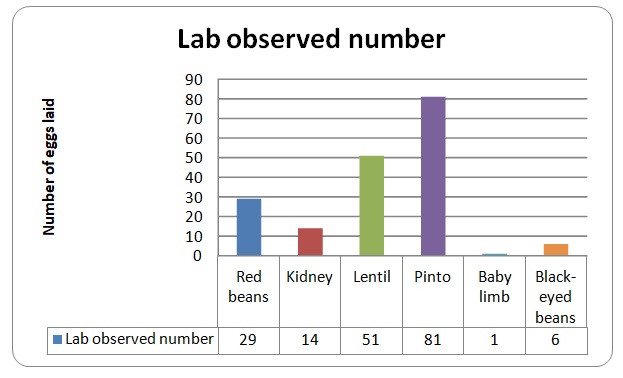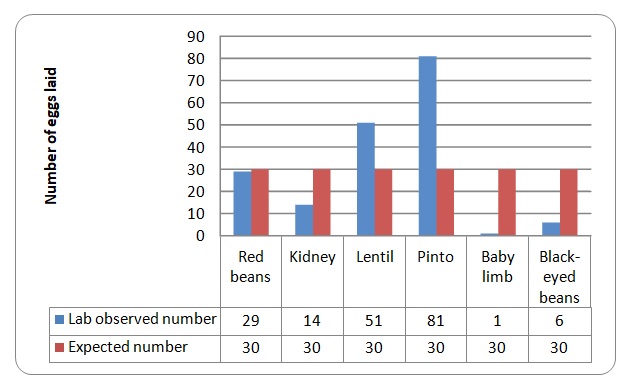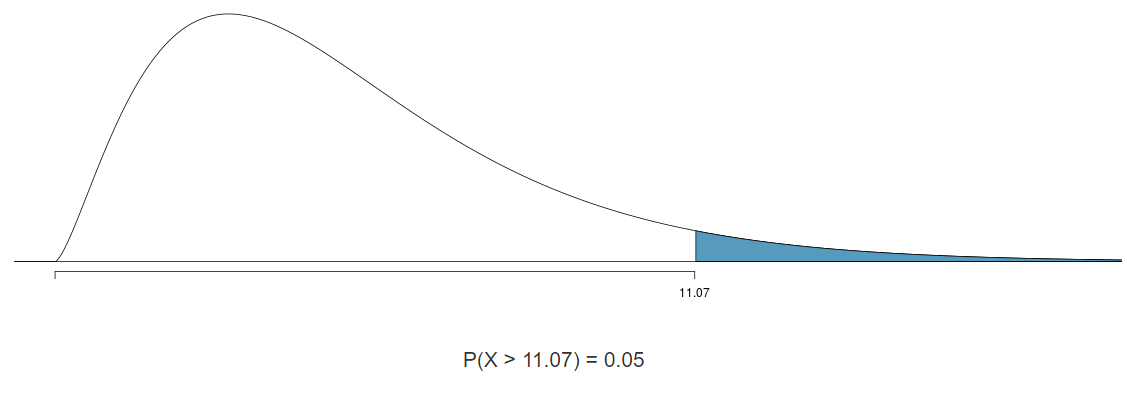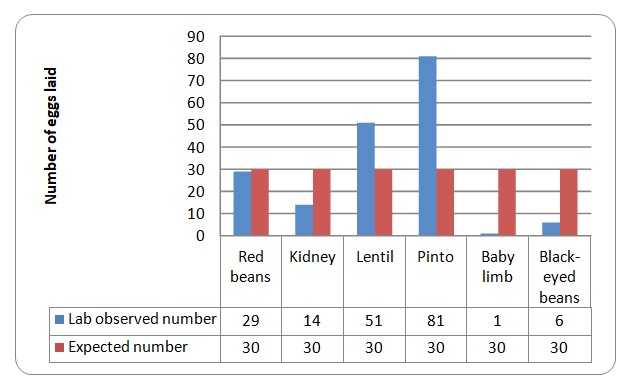Methods and Results Discussion
The purpose of this experiment was to determine if bean beetles have bean preferences for oviposition. To test this hypothesis, a Petri dish was covered with a single layer of beans, and 5 male and 5 female beetles were introduced for both the control and experimental groups. In such a way, a dense culture was produced that could sustain several generations.
The Petri dish with beans and beetles was placed in the assigned area in the lab. The temperature of 23℃ was favorable for mating and, consequently, for the production of eggs. The environmental variable chosen for testing was the type of bean. In total, there were 182 beans of six different types. To determine if beetles had bean preferences for oviposition, the number of eggs laid on each bean was counted. Then, the chi-squared test was performed to determine if the differences between the observed and the expected number of eggs laid on each bean were statistically significant.
There were 29 eggs laid on the red beans in the observed group, though the expected number of eggs was 30. There were 14 eggs laid on kidney beans, though the expected number of eggs was 30. There were 51 eggs laid on the lentil beans in the observed group, though the expected number of eggs was 30. There were 81 eggs laid on the pinto beans in the observed group, though the expected number of eggs was 30. There were only 1 egg laid on the baby limb and 6 eggs laid on black-eyed beans, though the expected number of eggs was 30 for each bean type.
The chi-squared test was performed, and the chi-square value was equal to 157.2. Since the variable (a bean type) has six levels, the number of degrees of freedom is five. The obtained chi-square value is greater than the critical chi-square value of 11.07. Thus, it is possible to conclude that bean beetles have bean preferences for oviposition at the significance level of 0.05. It can be seen that there is a significant preference for pinto beans and lentil beans, compared to baby limb and black-eyed beans.
At the next stage of the experiment, it was tested how a mother’s choice of substrate affected both her offspring’s survival rate and her reproductive success. To analyze this, the number and sex of beetles that hatched in each dish were recorded in the table. It appeared that even though there were 182 eggs in total, none of the beetles hatched from those eggs.
Therefore, for both the experimental group and the control group, the number of males and females hatched was equal to zero. Accordingly, the total number of beetles hatched per bean type was equal to zero. Thus, the hatch rate per bean type is equal to 0%. Since there were no adults alive, there was no point in determining if the sex ratio (males to females) is 50/50 using a chi-squared statistical test.
In summary, it has been proven that the oviposition behavior of female beetles depends on the type of bean. Specifically, lentil and pinto beans are the most preferred ones, and baby limb and black-eyed beans are the least preferred ones. However, the experiment did not aim to give a theoretical explanation of such oviposition preferences. Despite the fact that the beetle’s choice of the bean could impact the survival rate of her offspring, this assumption was not tested because there were no adults alive. The experiment is interesting as it can further the knowledge about the selection process for the female beetles.
Data Visualizations
Figure 1 shows how many eggs female beetles laid on each type of bean. It can be seen that female beetles preferred pinto and lentil beans over the other bean types. However, this assumption has to be tested using a chi-squared test to determine if the differences that are visible have statistical significance. Figure 2 compares the observed number of eggs to the expected number of eggs.


Figure 3 shows the chi-squared distribution for the five degrees of freedom. At the significance level of 0.05, the critical chi-square value is 11.07. The calculated chi-square value is greater than the critical chi-square value, which is why the differences in the number of eggs laid on each bean type between the observed and experimental groups are statistically significant. In other words, it is highly unlikely to obtain a similar difference (or a larger one) due to chance. This allowed for concluding that the oviposition behavior of female beetles is determined by the type of bean.

Figure 4 shows the observed number of adults (both males and females) hatched from eggs by bean type. There was no need to develop two different figures for the observed number of male and female adults hatched from eggs as no adults survived. The experiment did not intend to explain the survival rate of zero.

Butterflies
Butterflies are insects that have six jointed legs, four scale-covered wings, a three-section body, and an exoskeleton. Like all insects, butterflies have a four-stage life-cycle consisting of egg, larva, pupa, and adult. Even though butterfly wings are colorful and vibrant, they are actually transparent and made of long-chain polymer chitin. What makes them seem colorful is the light in different colors reflected by thousands of scales that cover the wings. As butterflies age, these scales fall from their wings, leaving transparent spots.
Interestingly, butterflies taste food with their feet on which taste sensors are located. To find a host plant and food, butterflies stand on a leaf, drumming it with their feet to determine if their caterpillars will be able to eat it. Only after a butterfly identified the right plant will it lay the eggs on it. Curiously enough, it has long been hypothesized that female insects lay eggs on plants that are associated with high larval performance. However, this hypothesis has not yet been proven as studies failed to find any strong link between oviposition behavior and larval performance.
Despite the fact that it was expected that oviposition preferences of female butterflies maximize the fitness of their offspring, no correlation between the two factors under natural and experimental settings was found (König et al. 2781). This may be explained by the impossibility of evaluating the suitability of the plant quality since butterflies usually lay eggs on all plants of a certain kind that they encounter. Another reason for the lack of correlation is the limited amount of time in which butterflies have to lay eggs.
Work Cited
König, Malin, et al. “Butterfly Oviposition Preference Is Not Related to Larval Performance on a Polyploid Herb.” Ecology and Evolution, vol. 6, no. 9, 2016, pp. 2781–2789.